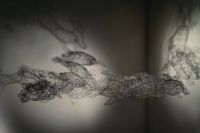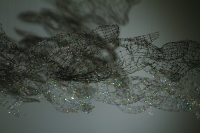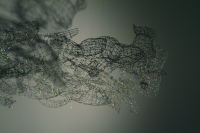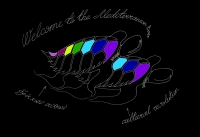“It is a big momentum of transition. A change in art that starts from Athens. How happy I am, and proud of the artists. They have deep knowledge and are not driven by the art market, but by the Gods.
(Strauss, Sky Radio Athens, 2010)
The dragon Python has not been killed by the young Apollon, only forced him to the ground. He has woken up to the riots and seeks to assist in the cultural revolution. The title “Welcome to the Mediterranean Basin” is a call for overcomming the colonial obsession of posession. No continents, no boders, just the oneness of the sea.
A large scale 3d-looking wire sculpture is part of Strauss’ sculptural system of “Mathematical Operation Animals”. It assembles five couples of hypolydian turtles and five lydian dogs in a circle. These characters embody the structure of the modulation of the Second Delphic Hymn to Apollon, which is otherwise hidden by signs and no longer perceivable to our ears. Ancient Greek music notation is, first of all, a notation of harmony. Therefore it can be
(per)formed as sculpture.
Video documentation of the sculpture:
An archaic dog carries the melody used in the rituals of 600 BC. It hesitantly touches two turtles, lydian scale of part one changes into the hypolydian two and so on… Limbs of the animal bodies display the dynamics of melody and explore the beautiful moments of transition between scales (modulation) as different states of hybrid beings. The turtle’s fin (oerótato pterígio), simultaneously is a leg of a dog (skiláki) which in turn becomes the aristocratic foot of a swan from the hypophrygian scale. At the end of the archaic part dragon Python “helps” Cultural Revolution and changes the classical part, composed by Limenios, furtherdeveloping the myth, the hymn, and the sculpture. The final, tenth part, is a wild dog (2010 CE) ouroborously finalising the composition by biting into its ansestor’s tail.
“Art that thinks, is always an art, which knows of its interplay with the media and lays it open. Hidden in media, it lets Physis reveal itself”, as Friedrich Kittler writes in a text, dedicated to Joulia Strauss. Her work, in opposition to subjectivity without content, usually reveals universally valid knowledge, but in very specific self invented languages of today.
Cultural Revolution neither understands itself as a “monument in the permanent state of becoming… to which every new passenger can add a further stone”, nor does it rethink itself as a “complete circular movement designating an orbital period with a begin and an end”. It is far from seeing violence as a manifestation of the Gods, but it questions the claim that art lacks the emanation of political energy. Image war is part of the war.
The floating Sculpture appears to become pure light, as thousands of spectrum particles cover its wire surface. It throws shadows in 3 directions and, moves with the melody, turning the exhibition space into a 3d animation. This speaks to an Ethos that contains a model of relations between characters in different stages of transformation,
resistance and insurrection, and calls on Friedrich Hölderlins “reliable laws of beauty” into a Presence. This dispositive organises the dispersed reality of the Empire by the rhythm of the Second Delphic Hymn to Apollon, which
is also a celebrative and poietic manifesto of artists in our dearly beloved Athens.



